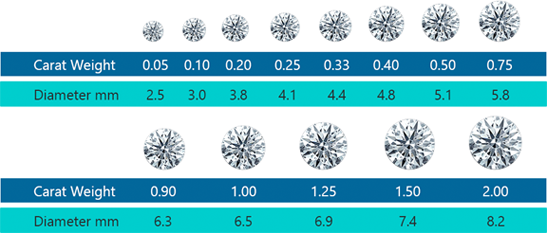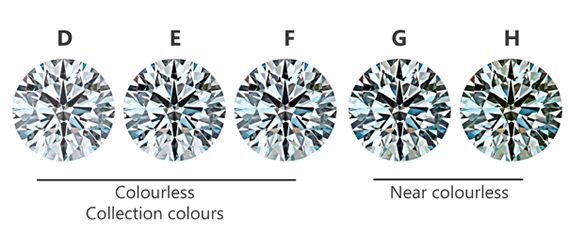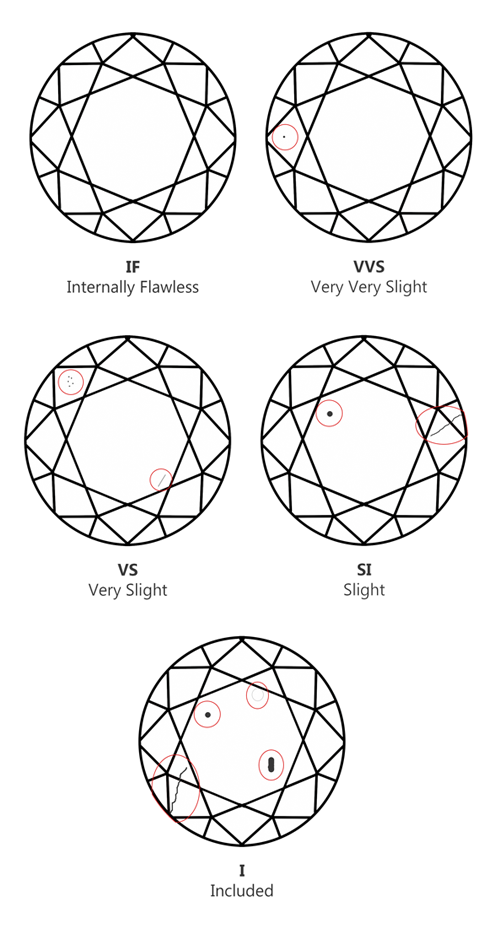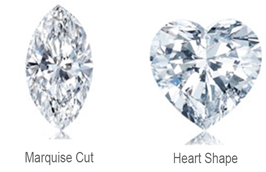Diamond Education
When buying a diamond, learning the basics will help you to make an educated choice. Luckily the basics are fairly easy to understand and involve getting to grips with only a few key points called the 4C’s; Carat – Colour – Clarity – Cut.Understanding these 4 attributes will make you feel like an expert and give you all the information you will need to choose the best diamond for your budget.
Optimal diameter/weight

(Indicative use only to show the differences between weights as this chart will appear different sizes on different devices)
Carat Weight
The carat weight of a diamond is just that, the weight. It does not dictate a diamond’s diameter as most people assume, but rather how heavy the diamond is. Some diamonds will appear a little smaller, as more of the diamond is left on the lower half of the diamond, making it deeper and giving it a smaller show. A shallow diamond, on the other hand, will appear a little larger, as there is less diamond on the lower half leaving the top to spread wider. There is, however, an optimal diameter, and this is shown in the chart below.
Top Tip
A larger diameter for a given weight will make a diamond appear bigger, but it is not always better. It will often appear lifeless and be lacking in sparkle. A smaller diameter for the same weight, however, will leak light through the sides and often appear too dark.
Diamond Colour
The colour of a white diamond is graded from D through to Z and it is normal for a diamond to show a slight taint of colour. The colour range D through to F will appear colourless and is therefore referred to as Collection Colours with only their brightness telling them apart. G and H colour diamonds will show no colour when viewed from the top but will start to show the first signs of colour when turned upside down. Although almost imperceptible, any signs of colour draw only really start from the colour I.
Fancy colour diamonds – In very rare instances, diamonds will exhibit a very strong hue of yellow, pink, blue or even red, green or violet. Colour draw on a white diamond lowers its value, whereas, on a fancy colour diamond, its strength will vastly increase its value. Really intense fancy colour diamonds are the rarest and most valuable available, generally regarded as the most investable.
Top Tip
The colour of a white diamond is graded in very small increments and it can be hard for most people to see the colour draw of a diamond right down to a K. The brightness, however, is unmistakable.


(As every monitor is different, this chart should be used as an indicator of the difference between colours and not taken as an exact colour reference)
(This explanation is based on the teachings of the GIA and will vary slightly with other laboratories)

(This is an indication of how different types of inclusions can affect the clarity grade- it in no way is meant to be a definitive example of what to expect from each)
Diamond Clarity
Formed in the earth’s mantle between 100 and 400 miles below the surface, diamonds have taken millions, if not billions of years to reach us today. It is therefore not hard to imagine that while they are growing, under tremendous pressure and temperature, small imperfections can arise in their crystal structure. A diamond’s clarity grade refers to the type, number and position of these imperfections.
Clarity grade explained
IF – Internally Flawless.
The most valuable clarity grade is, of course, the rarest.
VVS – Very Very Slight Inclusion
The Gemological Institute of America (see below) state that for a diamond to be classified as VVS any inclusion should be no larger than a pinpoint when viewed under a 10X magnification diamond loop.
VS – Very Slight Inclusion
A diamond grader will give a diamond the grade VS if its inclusion is larger than a pinpoint but still not obvious under a 10X magnification diamond loop.
SI – Small Inclusion
When an inclusion in a diamond is thought to be obvious under a 10X magnification loop to a trained diamond grader, the grade of SI will be given.
I – Included
Heavily included diamonds will have the grade I on the certificate and there will normally be multiple inclusions spread throughout the diamond.
Top Tip
Very good examples of SI clarity diamonds are called “ Clever SI’s” but are very hard to find, whereas VS diamonds normally strike the best balance of cost vs quality for most people.
Diamond Cut
Diamonds are either cut where every facet is a triangle or a straight line, but the term cut here actually refers to the shape of the diamond. Over the years certain shapes have become the accepted norm, as pictured below.
Top Tip
A round diamond (often referred to as a Brilliant cut) is timeless and the shape most associated with an engagement ring. It is, therefore, the safest choice if you are unsure which to buy.



Different Certificates And Gem Labs
The International Diamond Grading system was created by the Gemological Institute of America (GIA) in 1953, its sole purpose to protect buyers and sellers. In two short years, the Diamond Grading Report (certificate) became an internationally accepted safeguard that would accompany most significant diamonds.
Today there are various gemological laboratories around the globe, all with the objective of independently grading diamonds. They use the same grading scale but not all employ the same tolerances between grades.
Top Tip
GIA certificates generally have the toughest standards and are the only certificates commercially recognised all over the world.
Cut, Polish And Symmetry
These three attributes are often overlooked on a certificate, but they can be very useful when choosing your diamond. They are graded as Excellent - Very good - Good – Fair with fair normally being regarded as substandard and best avoided.
Cut – Refers to the proportions and angles of a diamond combined with the general pattern created within.
Polish– Indicates if any unwanted traces of the industrial process remain visible on the diamond.
Symmetry– Maximum light refraction is only possible when all facets are symmetrical, fully formed and line up with one another.
Top Tip
Diamonds that are graded with Excellent for all the above three attributes are referred to as Triple Excellent diamonds and normally attract a premium.
Fluorescence
Around 25-30% of all diamonds will emit a visible light when subjected to ultraviolet rays. This shows as a blue or yellow/orange glow and has various degrees of intensity. It will read on a diamond’s certificate as Nil – Faint – Medium - Strong – Very Strong.
Top Tip
Diamonds with little or no colour (D through J) that exhibit medium or stronger levels of fluorescence, can often show slightly milky in daylight, greatly reducing their value. Conversely, diamonds that draw* (*meaning show a colour), normally regarded as K downwards, can benefit from a stronger fluorescence rating as it can make them appear as one or two colours whiter.
 0207 404 4022
0207 404 4022  Wishlist
Wishlist 
